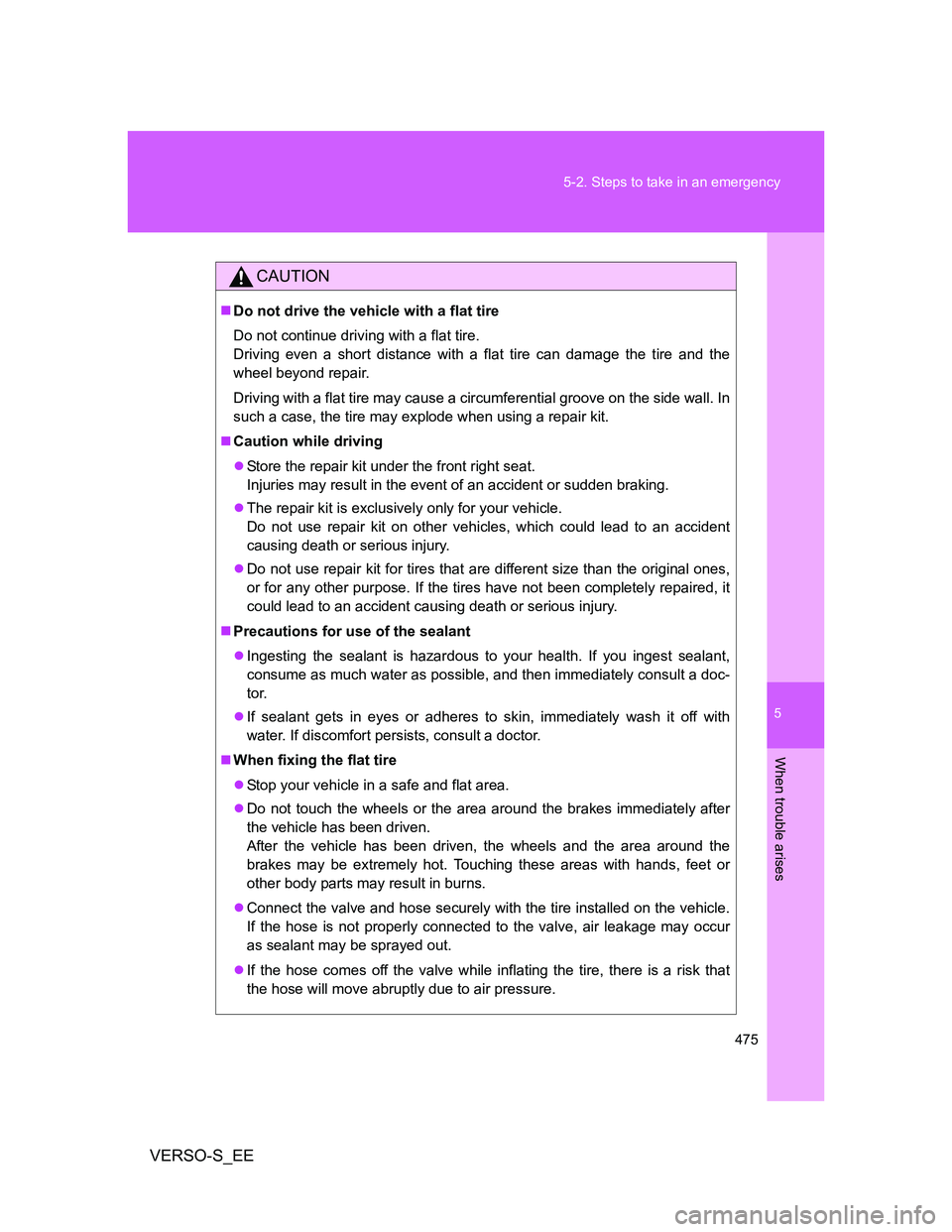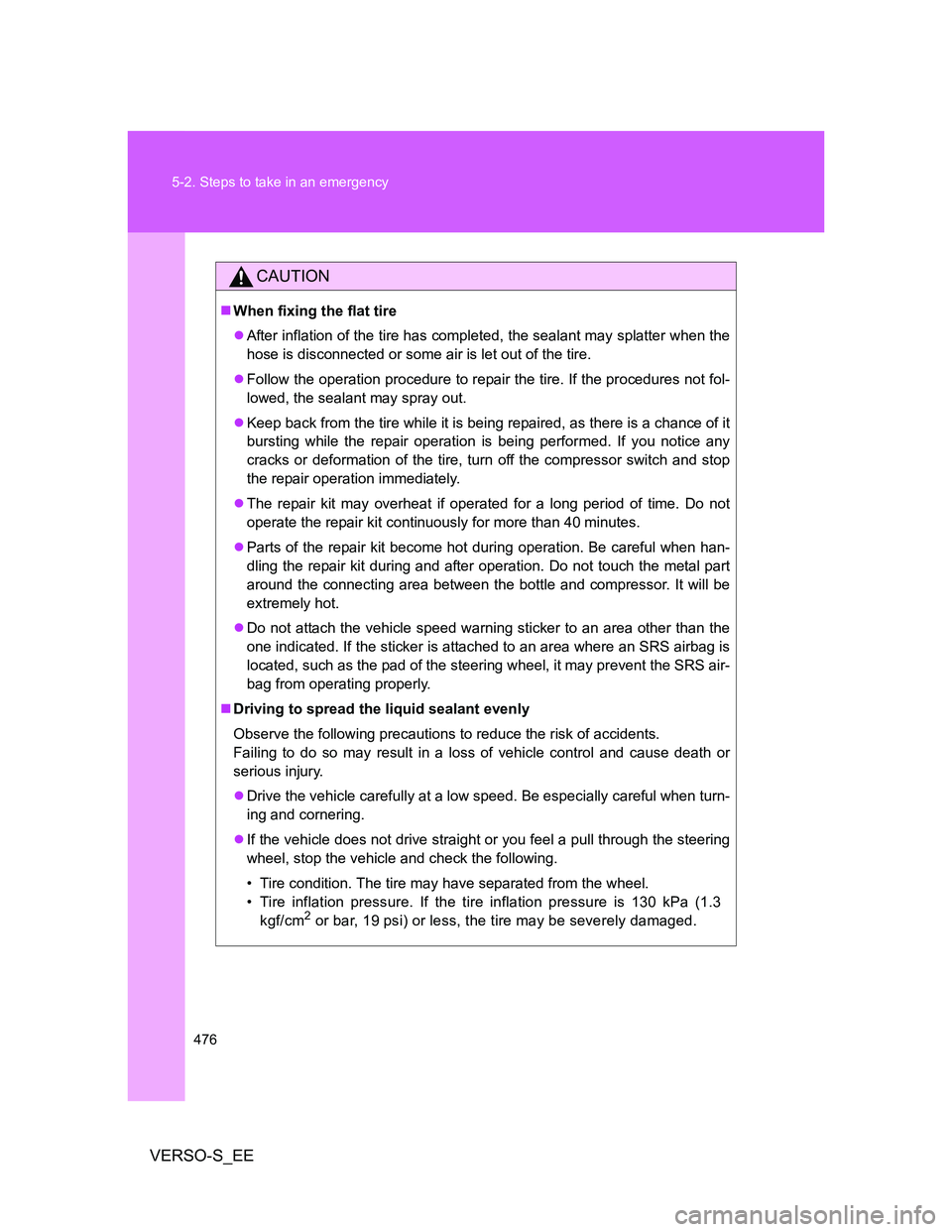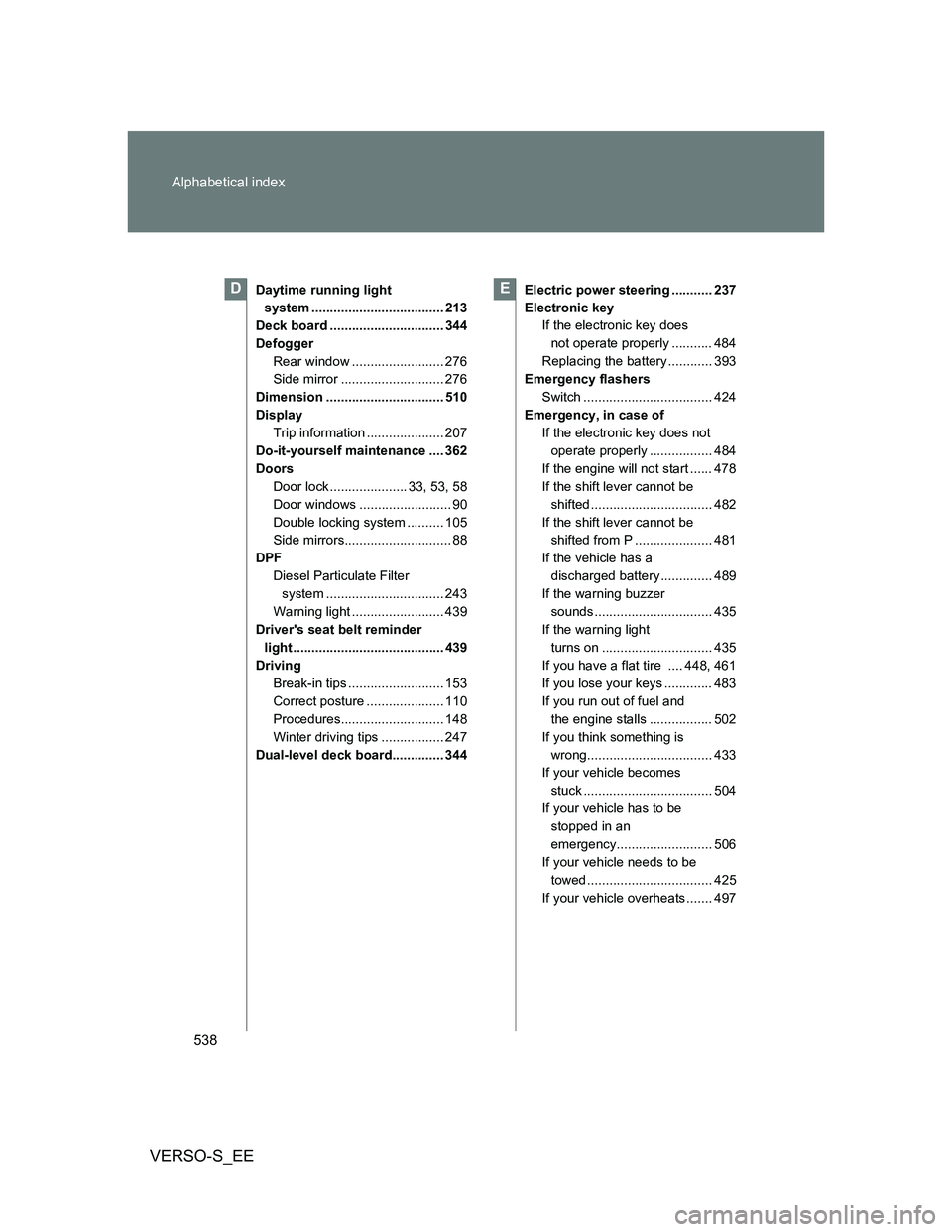Page 470 of 552

470 5-2. Steps to take in an emergency
VERSO-S_EEInflate the tire until the specified
air pressure is reached.
The sealant will be injected
and the pressure will surge
and then gradually decrease.
The air pressure gauge will
display the actual tire inflation
pressure about 1 minute (5
minutes at low temperature)
after the switch is turned on.
Inflate the tire until the speci-
fied air pressure.
• Turn the compressor switch off
and then check the tire inflation
pressure. Being careful not to
over inflate, check and repeat
the inflation procedure until the
specified tire inflation pressure
is reached.
• If the tire inflation pressure is
still lower than the specified
point after inflation for 35 min-
utes with the switch on, the tire
is too damaged to be repaired.
Turn the compressor switch off
and contact any authorized
Toyota dealer or repairer, or
another duly qualified and
equipped professional.
• If the tire inflation pressure
exceeds the specified air pres-
sure, let out some air to adjust
the tire inflation pressure.
(P. 473, 523)
STEP14
Page 471 of 552
5
471 5-2. Steps to take in an emergency
When trouble arises
VERSO-S_EEWith the compressor switch off, disconnect the hose from the
valve on the tire and then pull out the power plug from the
power outlet socket.
Some sealant may leak when the hose is removed.
Install the valve cap onto the valve of the emergency repaired
tire.
Attach the air release cap to the
end of the hose.
If the air release cap is not
attached, the sealant may leak
and the vehicle may get dirty.
Temporarily store the bottle in the luggage compartment while
it is connected to the compressor.
To spread the liquid sealant evenly within the tire, immediately
drive safely for about 5 km (3 miles) below 80 km/h (50 mph).
After driving for about 5 km (3
miles), stop your vehicle in a
safe place on a hard, flat surface
and remove the air release cap
from the hose before reconnect-
ing the repair kit.
STEP15
STEP16
STEP17
STEP18
STEP19
STEP20
Page 472 of 552

472 5-2. Steps to take in an emergency
VERSO-S_EETurn the compressor switch on
and wait for an approximately 5
seconds, and then turn it off.
Check the tire inflation pressure.
If the tire inflation pressure is
under 130 kPa (1.3 kgf/cm
2 or
bar, 19 psi): The puncture can-
not be repaired. Contact any
authorized Toyota dealer or
repairer, or another duly quali-
fied and equipped profes-
sional.
If the tire inflation pressure is
130 kPa (1.3 kgf/cm
2 or bar,
19 psi) or higher, but less than
the specified air pressure:
Proceed to .
If the tire inflation pressure is
the specified air pressure
(P. 523): Proceed to .
Turn the compressor switch on to inflate the tire until the spec-
ified air pressure is reached. Drive for about 5 km (3 miles)
and then perform .
Attach the air release cap to the
end of the hose.
If the air release cap is not
attached, the sealant may leak
and the vehicle may get dirty.
Store the bottle in the luggage compartment while it is con-
nected to the compressor.
STEP21
STEP22
STEP23
STEP22
STEP20
STEP23
STEP24
Page 473 of 552

5
473 5-2. Steps to take in an emergency
When trouble arises
VERSO-S_EETaking precautions to avoid sudden braking, sudden accelera-
tion and sharp turns, drive carefully at under 80 km/h (50
mph) to the nearest authorized Toyota dealer or repairer, or
another duly qualified and equipped professional for tire repair
or replacement.
If the tire is inflated to more than the specified air pressure
Disconnect the hose from the valve.
Disconnect the hose from the valve, remove the air release cap
from the hose and then reconnect the hose.
Turn the compressor switch on and wait for several seconds, and
then turn it off. Check that the air pressure indicator shows the
specified air pressure.
If the air pressure is under the designated pressure, turn the com-
pressor switch on again and repeat the inflation procedure until the
specified air pressure is reached.
The valve of a tire that has been repaired
After a tire is repaired with the emergency tire puncture repair kit, the valve
should be replaced.
Note for checking the emergency tire puncture repair kit
Check the sealant expiry date occasionally.
The expiry date is shown on the bottle. Do not use sealant whose expiry
date has already passed. Otherwise, repairs conducted using the emer-
gency tire puncture repair kit may not be performed properly.
STEP25
STEP1
Install the air release cap to the end of the
hose and push the protrusion on the air
release cap into the tire valve to let some
air out.STEP2
STEP3
STEP4
Page 475 of 552

5
475 5-2. Steps to take in an emergency
When trouble arises
VERSO-S_EE
CAUTION
Do not drive the vehicle with a flat tire
Do not continue driving with a flat tire.
Driving even a short distance with a flat tire can damage the tire and the
wheel beyond repair.
Driving with a flat tire may cause a circumferential groove on the side wall. In
such a case, the tire may explode when using a repair kit.
Caution while driving
Store the repair kit under the front right seat.
Injuries may result in the event of an accident or sudden braking.
The repair kit is exclusively only for your vehicle.
Do not use repair kit on other vehicles, which could lead to an accident
causing death or serious injury.
Do not use repair kit for tires that are different size than the original ones,
or for any other purpose. If the tires have not been completely repaired, it
could lead to an accident causing death or serious injury.
Precautions for use of the sealant
Ingesting the sealant is hazardous to your health. If you ingest sealant,
consume as much water as possible, and then immediately consult a doc-
tor.
If sealant gets in eyes or adheres to skin, immediately wash it off with
water. If discomfort persists, consult a doctor.
When fixing the flat tire
Stop your vehicle in a safe and flat area.
Do not touch the wheels or the area around the brakes immediately after
the vehicle has been driven.
After the vehicle has been driven, the wheels and the area around the
brakes may be extremely hot. Touching these areas with hands, feet or
other body parts may result in burns.
Connect the valve and hose securely with the tire installed on the vehicle.
If the hose is not properly connected to the valve, air leakage may occur
as sealant may be sprayed out.
If the hose comes off the valve while inflating the tire, there is a risk that
the hose will move abruptly due to air pressure.
Page 476 of 552

476 5-2. Steps to take in an emergency
VERSO-S_EE
CAUTION
When fixing the flat tire
After inflation of the tire has completed, the sealant may splatter when the
hose is disconnected or some air is let out of the tire.
Follow the operation procedure to repair the tire. If the procedures not fol-
lowed, the sealant may spray out.
Keep back from the tire while it is being repaired, as there is a chance of it
bursting while the repair operation is being performed. If you notice any
cracks or deformation of the tire, turn off the compressor switch and stop
the repair operation immediately.
The repair kit may overheat if operated for a long period of time. Do not
operate the repair kit continuously for more than 40 minutes.
Parts of the repair kit become hot during operation. Be careful when han-
dling the repair kit during and after operation. Do not touch the metal part
around the connecting area between the bottle and compressor. It will be
extremely hot.
Do not attach the vehicle speed warning sticker to an area other than the
one indicated. If the sticker is attached to an area where an SRS airbag is
located, such as the pad of the steering wheel, it may prevent the SRS air-
bag from operating properly.
Driving to spread the liquid sealant evenly
Observe the following precautions to reduce the risk of accidents.
Failing to do so may result in a loss of vehicle control and cause death or
serious injury.
Drive the vehicle carefully at a low speed. Be especially careful when turn-
ing and cornering.
If the vehicle does not drive straight or you feel a pull through the steering
wheel, stop the vehicle and check the following.
• Tire condition. The tire may have separated from the wheel.
• Tire inflation pressure. If the tire inflation pressure is 130 kPa (1.3
kgf/cm
2 or bar, 19 psi) or less, the tire may be severely damaged.
Page 523 of 552
523 6-1. Specifications
6
Vehicle specifications
VERSO-S_EE
Tires and wheels
Tire size185/65R15 88H, 185/60R16 86H,
T135/70D16 100M
Tire inflation pressure
(Recommended cold tire
inflation pressure)230 kPa (2.3 kgf/cm2 or bar, 33 psi)
Tire inflation pressure
(compact spare)
(Recommended cold tire
inflation pressure)420 kPa (4.2 kgf/cm
2 or bar, 60 psi)
Wheel size15 5 1/2 J, 16 5 1/2 J, 16 4T (compact
spare)
Wheel nut torque 103 N•m (10.5 kgf•m, 76 ft•lbf)
Page 538 of 552

538 Alphabetical index
VERSO-S_EE
Daytime running light
system .................................... 213
Deck board ............................... 344
Defogger
Rear window ......................... 276
Side mirror ............................ 276
Dimension ................................ 510
Display
Trip information ..................... 207
Do-it-yourself maintenance .... 362
Doors
Door lock ..................... 33, 53, 58
Door windows ......................... 90
Double locking system .......... 105
Side mirrors............................. 88
DPF
Diesel Particulate Filter
system ................................ 243
Warning light ......................... 439
Driver's seat belt reminder
light ......................................... 439
Driving
Break-in tips .......................... 153
Correct posture ..................... 110
Procedures............................ 148
Winter driving tips ................. 247
Dual-level deck board.............. 344Electric power steering ........... 237
Electronic key
If the electronic key does
not operate properly ........... 484
Replacing the battery ............ 393
Emergency flashers
Switch ................................... 424
Emergency, in case of
If the electronic key does not
operate properly ................. 484
If the engine will not start ...... 478
If the shift lever cannot be
shifted ................................. 482
If the shift lever cannot be
shifted from P ..................... 481
If the vehicle has a
discharged battery .............. 489
If the warning buzzer
sounds ................................ 435
If the warning light
turns on .............................. 435
If you have a flat tire .... 448, 461
If you lose your keys ............. 483
If you run out of fuel and
the engine stalls ................. 502
If you think something is
wrong.................................. 433
If your vehicle becomes
stuck ................................... 504
If your vehicle has to be
stopped in an
emergency.......................... 506
If your vehicle needs to be
towed .................................. 425
If your vehicle overheats ....... 497DE